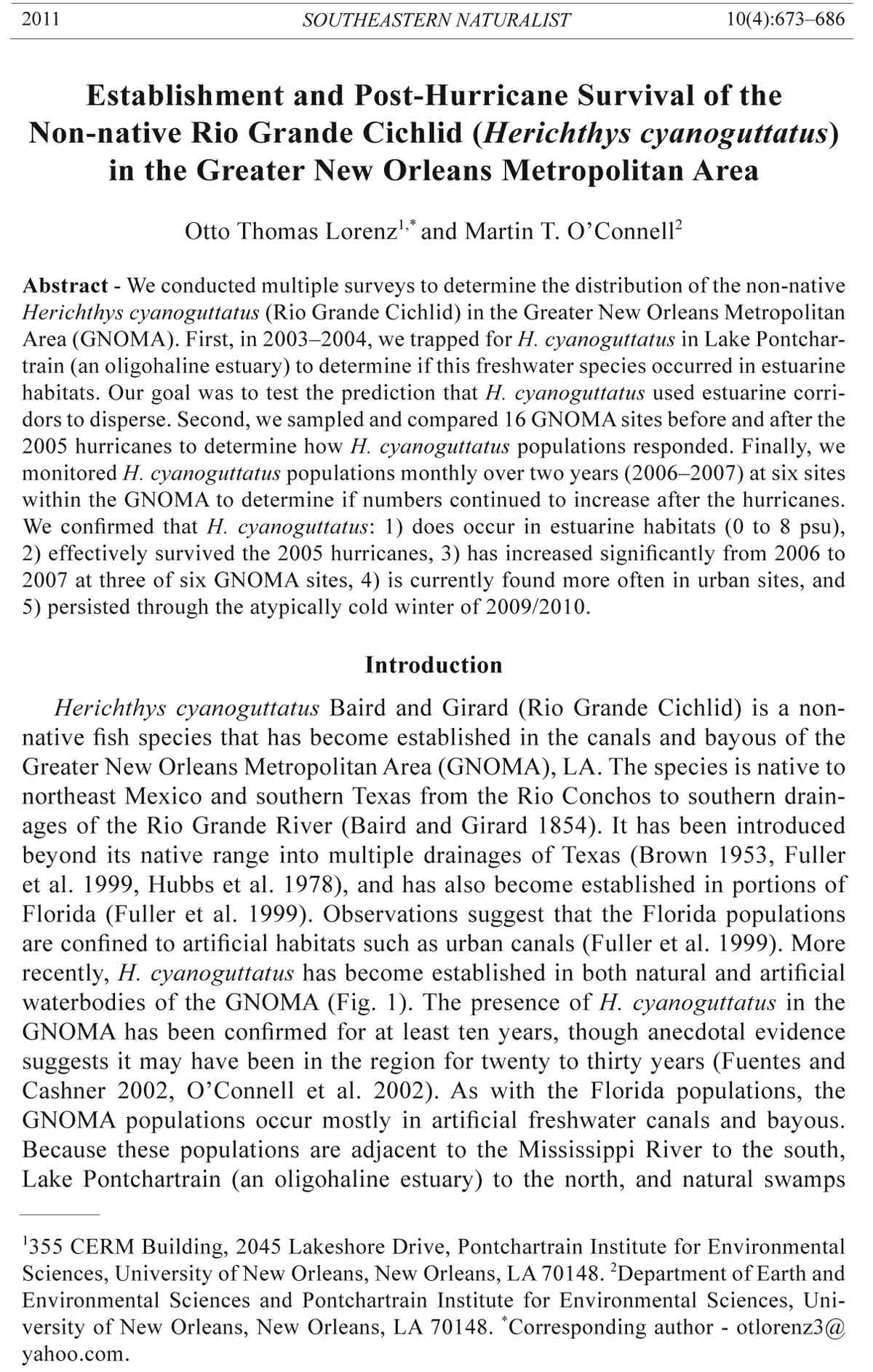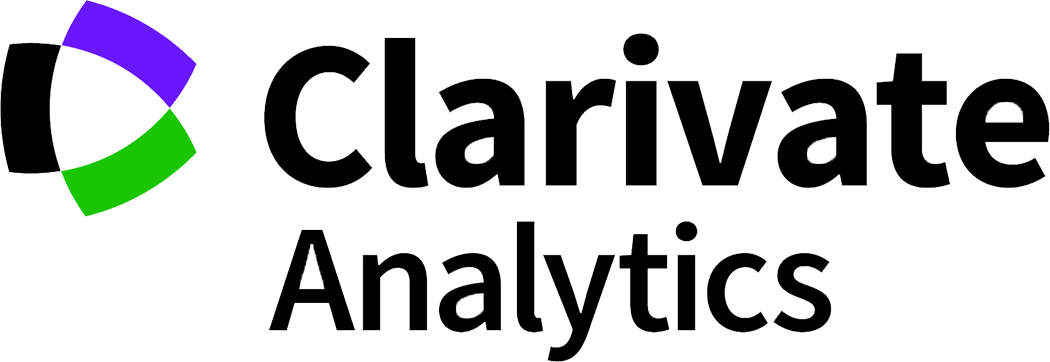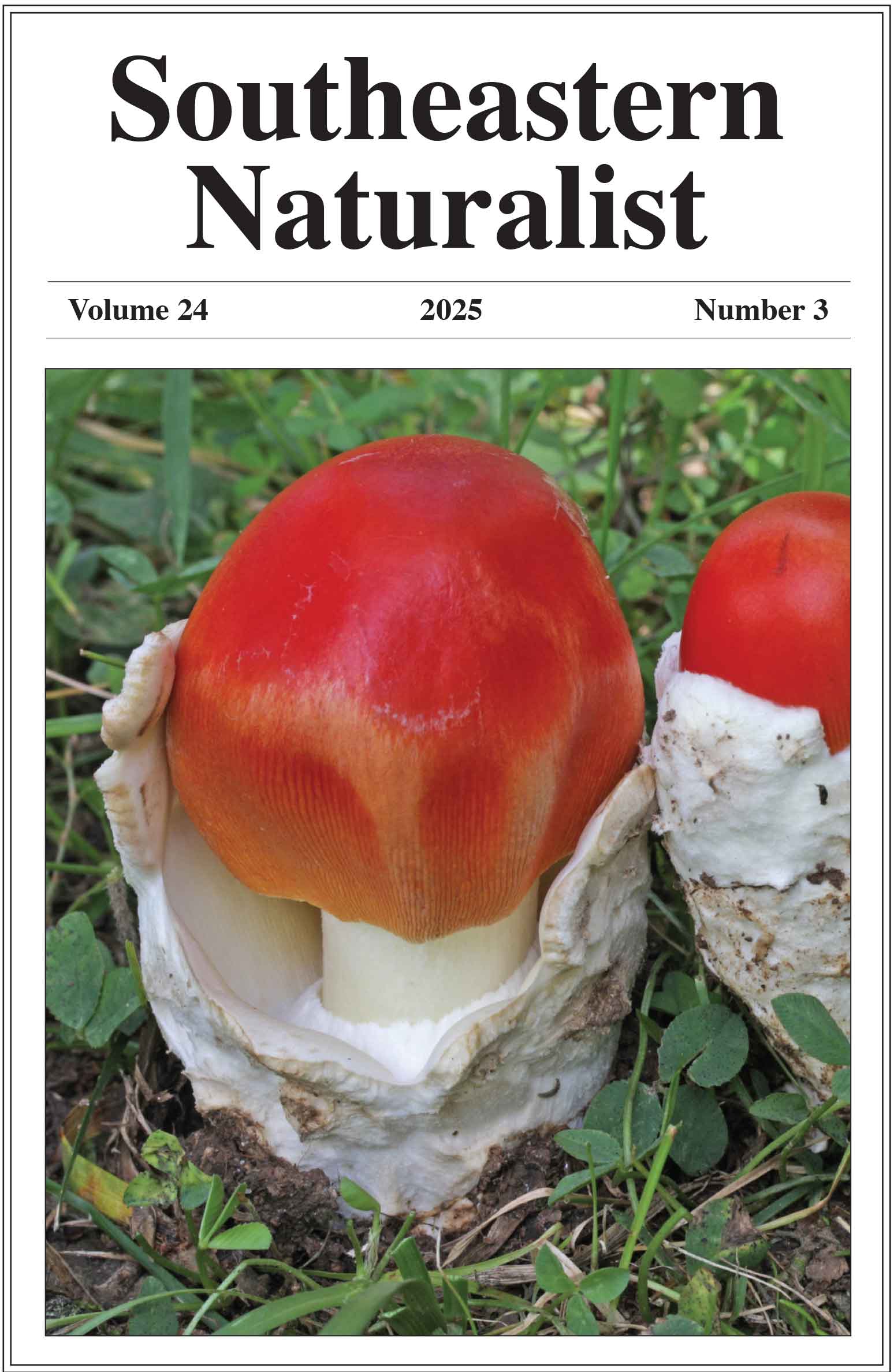Establishment and Post-Hurricane Survival of the
Non-native Rio Grande Cichlid (Herichthys cyanoguttatus)
in the Greater New Orleans Metropolitan Area
Otto Thomas Lorenz and Martin T. O’Connell
Southeastern Naturalist, Volume 10, Issue 4 (2011): 673–686
Full-text pdf (Accessible only to subscribers.To subscribe click here.)

2011 SOUTHEASTERN NATURALIST 10(4):673–686
Establishment and Post-Hurricane Survival of the
Non-native Rio Grande Cichlid (Herichthys cyanoguttatus)
in the Greater New Orleans Metropolitan Area
Otto Thomas Lorenz1,* and Martin T. O’Connell2
Abstract - We conducted multiple surveys to determine the distribution of the non-native
Herichthys cyanoguttatus (Rio Grande Cichlid) in the Greater New Orleans Metropolitan
Area (GNOMA). First, in 2003–2004, we trapped for H. cyanoguttatus in Lake Pontchartrain
(an oligohaline estuary) to determine if this freshwater species occurred in estuarine
habitats. Our goal was to test the prediction that H. cyanoguttatus used estuarine corridors
to disperse. Second, we sampled and compared 16 GNOMA sites before and after the
2005 hurricanes to determine how H. cyanoguttatus populations responded. Finally, we
monitored H. cyanoguttatus populations monthly over two years (2006–2007) at six sites
within the GNOMA to determine if numbers continued to increase after the hurricanes.
We confirmed that H. cyanoguttatus: 1) does occur in estuarine habitats (0 to 8 psu),
2) effectively survived the 2005 hurricanes, 3) has increased significantly from 2006 to
2007 at three of six GNOMA sites, 4) is currently found more often in urban sites, and
5) persisted through the atypically cold winter of 2009/2010.
Introduction
Herichthys cyanoguttatus Baird and Girard (Rio Grande Cichlid) is a nonnative
fish species that has become established in the canals and bayous of the
Greater New Orleans Metropolitan Area (GNOMA), LA. The species is native to
northeast Mexico and southern Texas from the Rio Conchos to southern drainages
of the Rio Grande River (Baird and Girard 1854). It has been introduced
beyond its native range into multiple drainages of Texas (Brown 1953, Fuller
et al. 1999, Hubbs et al. 1978), and has also become established in portions of
Florida (Fuller et al. 1999). Observations suggest that the Florida populations
are confined to artificial habitats such as urban canals (Fuller et al. 1999). More
recently, H. cyanoguttatus has become established in both natural and artificial
waterbodies of the GNOMA (Fig. 1). The presence of H. cyanoguttatus in the
GNOMA has been confirmed for at least ten years, though anecdotal evidence
suggests it may have been in the region for twenty to thirty years (Fuentes and
Cashner 2002, O’Connell et al. 2002). As with the Florida populations, the
GNOMA populations occur mostly in artificial freshwater canals and bayous.
Because these populations are adjacent to the Mississippi River to the south,
Lake Pontchartrain (an oligohaline estuary) to the north, and natural swamps
1355 CERM Building, 2045 Lakeshore Drive, Pontchartrain Institute for Environmental
Sciences, University of New Orleans, New Orleans, LA 70148. 2Department of Earth and
Environmental Sciences and Pontchartrain Institute for Environmental Sciences, University
of New Orleans, New Orleans, LA 70148. *Corresponding author - otlorenz3@
yahoo.com.
674 Southeastern Naturalist Vol. 10, No. 4
and marshes to the east (Bayou Sauvage National Wildlife Refuge) and west (La
Branche Wetlands), there is a need to determine if this non-native fish is capable
of expanding its range beyond the artificial habitats it currently occupies.
A dispersion model, developed to better understand the dynamics of the early
stages of expansion, suggested that populations of H. cyanoguttatus, nominally
a freshwater species, were dispersing into new areas by traveling through lowsalinity
conditions (5 to 12 psu) in Lake Pontchartrain (O’Connell et al. 2002).
Should this be the case, an important implication is that estuarine habitats may not
serve as a barrier to continued H. cyanoguttatus expansion beyond the GNOMA
and into valuable nearby fishery habitat. Lorenz and O’Connell (2008) have
shown this species to tolerate salinities of at least 16 psu, while the closely related
and invasive Hemichromis letourneuxi Sauvage (African Jewelfish) from Florida
has survived in salinity ranges up to 50 psu (Langston et al. 2010).
Biotic resistance is another possible barrier to invasive species, as shown with
Callinectes sapidus Rathburn (Blue Crab) affecting the invasion of Carcinus
maenas L. (Green Crab) (Jensen et al. 2007), and with predacious fish affecting
the range of introduced Speckled Dace Girard (Rhinichthys osculus) in California
(Harvey et al. 2004). It is possible that the natural swamps and marshes outside of
the GNOMA will offer some form of biotic resistance to further H. cyanoguttatus
expansion. Since the 1990s, specimens of H. cyanoguttatus have been periodically
collected in natural water bodies beyond the urban habitats such as the La
Branche Wetlands west of the GNOMA (C. Schieble, University of New Orleans,
New Orleans, LA, and A. Cheek, B. Henry, and S. Temple, Southeastern Louisiana
University, Hammond, LA, pers. observ.; Fig. 1). Although H. cyanoguttatus
has occurred in considerable numbers in these wetlands, their occurrence is never
as consistent as it is in the more urban GNOMA habitats. One of our goals is to
examine the possible roles of salinity and biotic resistance in determining the
expansion of H. cyanoguttatus in the region.
The levee failures that followed hurricanes Katrina and Rita in 2005 inundated
large portions of the GNOMA with estuarine waters. These disasters interrupted
our survey efforts for H. cyanoguttatus. We used this opportunity to also conduct
a pre/post hurricane comparison to determine if range expansion was affected by
the hurricane and subsequent effects. We sampled repeatedly in 2005 and 2006
pre- and post-hurricanes at the same sampling locations and approximately during
the same time of year. To further explore possible post-hurricane effects, we
conducted additional monthly samples at another six sites in Bayou St. John and
other City Park water bodies from January 2006 to December 2007. These sites
are located in the north-central portion of Orleans Parish, and were inundated with
floodwaters for approximately three weeks in 2005 (Fig. 1). While H. cyanoguttatus
occurred in Bayou St. John prior to the levee failures, the non-native species
had only just begun to disperse into City Park water bodies in 2005. Based on these
surveys, we aimed to answer the following questions: 1) Does H. cyanoguttatus
occur in Lake Pontchartrain estuarine habitats as predicted by the dispersion model?
2) Did populations of H. cyanoguttatus survive the effects of the 2005 levee
failures and hurricanes? 3) Has H. cyanoguttatus increased in numbers in Bayou
St. John and other City Park water bodies since the hurricanes?
2011 O.T. Lorenz and M.T. O’Connell 675
Methods
In order to document the success and spread of H. cyanoguttatus in GNOMA,
three surveys were conducted: (1) to study the possibility that the lake serves as a
corridor, (2) to determine the range of the cichlids and possible hurricane effects,
and (3) to monitor the spread of cichlids post-hurricane at focal locations.
Field sites
Aquatic habitats in the GNOMA include canals and other modified waterways
within the City of New Orleans and its suburbs. We expanded sampling
into field sites just outside of the GNOMA to examine the possible expansion
of H. cyanoguttatus into more natural areas. These areas include wetlands with
no concrete canals or direct urban runoff. The sites in Lake Pontchartrain were
located on a concrete seawall that extends into deep estuarine (5 to 12 psu) water.
Abiotic conditions at most of these sites are similar, relatively alkaline and hard
Figure 1. Sampling locations for three different surveys of H. cyanoguttatus in the
GNOMA. Triangles represent the seawall study. Squares represent the Bayou St. John
and City Park study. Circles represent sites sampled for the pre- and post-hurricane survey.
Dark circles represent where H. cyanoguttatus was not collected. Sites numbered
are: 1. Bayou Trepagnier, 2. LaBranche wetlands, 3. West Kenner, 4. Mississippi River,
5. Veterans Canal, 6. Harahan, 7. Bonnabel Canal, 8. Marconi Lagoon, 9. Metairie Bayou
City Park, 10. Pontchartrain Lagoon City Park, 11. Bayou St. John South, 12. Bayou St.
John Central, 13. Bayou St. John North, 14–16. Seawall sampling sites, 17. St. Bernard
Parish, 18. St. Charles Canal, 19. Gannon Canal, 20. Bayou Sauvage, 21. Algiers, and
22. Bayou Segnette.
676 Southeastern Naturalist Vol. 10, No. 4
water with pH consistently above 7 and general hardness above 100. The most
variable abiotic variable is salinity, which varies tidally and seasonally.
Potential estuarine corridors survey (2003–2004)
To test the prediction that H. cyanoguttatus uses estuarine habitats as dispersal
corridors, we placed traps along the armored seawall that covers most of the
southern shore of Lake Pontchartrain (Fig. 1). This artificial habitat represents
a challenge to most conventional fish-collecting methods because it consists of
12–15 concrete steps (30-cmd height) that extend from land to below the water
surface. The area of high-energy turbulence associated with the edge of the
seawall precludes safe collection of fishes with gillnets, seines, or hoopnets. Electrofi
shing along the seawall is also impractical because of periodically elevated
salinities (over 8 psu). Trapping was conducted from February 2003 to January
2004 at three sampling sites near the mouth of London Avenue Canal, which
flows into Lake Pontchartrain, near the University of New Orleans in the northcentral
region of Orleans Parish (Fig. 1). We constructed nine double-funnel traps
(90 x 40 x 20 cm) with openings of 15 x 8 cm. These were custom-designed to fit
on the seawall and capture fishes moving along the inundated steps (mean depth
of 1.5 m). Traps were constructed of plastic-treated mesh (3 x 1 cm) of the type
used for crab traps. Similar traps have been used to capture H. cyanoguttatus in
Texas (Buchanan 1971). Both adult and juvenile H. cyanoguttatus have been collected
from London Avenue Canal, making it a potential source for individuals
moving into or through the lake, as these canals end at pumping stations, which
pump water into the lake. The double-funnel traps allowed us to determine the
direction of fish movement along the seawall, with funnels facing either towards
or away from the mouth of London Avenue Canal.
The three sampling sites were located approximately 200 m apart along the
seawall, and three traps were fished along the three uppermost inundated steps
at each site. Sampling consisted of setting funnel traps once monthly for a year,
with all traps being simultaneously fished from sunrise to sunset. Funnel traps
were baited with raw chicken necks, and during high wave conditions, the traps
were weighted down with cinder blocks. Salinity (psu) and temperature (ºC) were
measured five times throughout the day (sunrise, 0900, noon, 1500, and sunset)
at each site during each sampling period using a YSI meter (model 63). All fishes
collected were anesthetized with sodium bicarbonate, fixed in 10% formalin,
and preserved in 70% ethanol. Fishes were later identified, counted, weighed to
the nearest gram, and measured to the nearest mm standard length (SL), and all
specimens were added to the University of New Orleans Vertebrate Collection.
Pre- and post-hurricane surveys (2005–2006)
Since an early survey of sites in Orleans and Jefferson parishes in 1998 (Fuentes
and Cashner 2002), there has been no assessment of the geographical extent of
H. cyanoguttatus’ range within and outside of the GNOMA. We surveyed 16 sites
in and around the GNOMA to determine which regions contained H. cyanoguttatus
populations (Fig. 1). Sampling consisted of trapping with the funnel traps used
in the 2003 seawall survey. Site selection was based on our attempt to sample
2011 O.T. Lorenz and M.T. O’Connell 677
known and potential expansion sites for H. cyanoguttatus (O.T. Lorenz and M.T.
O’Connell pers. observ.). Among the sites we identified, two were in Lake
Pontchartrain, one in the Mississippi River, and two (Bayou Segnette and Algiers)
were across the River on the West Bank (one of which, Bayou Segnette, is a natural
waterway). Other sites included two natural waterways to the west of the GNOMA
(a small bayou near the Town of Ruddock and Bayou Trepagnier) and one natural
site to the east (Bayou Sauvage). The remaining seven sites were located within
the more urbanized sections of the GNOMA, but included Bayou St. John, a seminatural
water body that is part of the City Park lagoon system (Fig. 1).
Trapping was conducted over a six-week period from June to mid-July 2005 and
consisted of 20-h overnight sets of each trap, with three traps per site (total of three
trap-nights per site). Traps were baited with canned catfood. Water temperature,
general hardness, carbonate hardness, salinity, pH, and dissolved oxygen were
measured using a YSI meter (model 63) at each sampling location. All trapped
H. cyanoguttatus and native sunfishes (Centrarchidae) were counted. We focused
solely on sunfishes because these are the most common fishes found in association
with H. cyanoguttatus and are the most likely to be interacting with the non-native
fish over spawning sites (O.T. Lorenz and M.T. O’Connell, pers. observ.).
To determine if the 2005 hurricanes impacted the abundance or distribution
of H. cyanoguttatus at these sites, we repeated these survey methods in identical
fashion the following summer from June to mid-July 2006. The number
of fishes collected between these two periods was compared using a paired,
non-parametric sign test (SPSS v. 15.0). We chose a conservative test (sign
test) because of the low sample size. Whether more fishes were caught in urban
or natural environments was tested with a multivariate general linear model
(Wilks’ Lambda), using the sites listed in Table 1 as urban or natural. These
methods were used because the data were not normally distributed. Although
environmental data were unreplicated, we combined these data for both years
and ran multiple regression models to determine if environmental data could
predict abundances of each species collected.
Bayou St. John and City Park survey (2006–2007)
As part of a survey to assess post-hurricane population recovery in Bayou St.
John and other water bodies located in City Park, we sampled six sites monthly
for two years from January 2006 to December 2007. These sites are of particular
interest because they are stocked with gamefish and are fished more than the sites
sampled in the GNOMA study. The three Bayou St. John sites (Bayou St. John
North, Central, and South) are considered estuarine, receiving intermittent water
from Lake Pontchartrain to the north (Fig. 1). The Bayou St. John North site
is closest to Lake Pontchartrain and tends to have higher salinities (2006 salinity
range = 7.0–8.1 psu) than the other five sites. Salinities are slightly lower at the
central (2006 salinity range = 6.4–7.7 psu) and south Bayou St. John sites (2006 salinity
range = 6.9–7.8 psu). The three City Park sites are less saline (2.3 to 5.4 psu),
though indirectly connected to Bayou St. John though various pump systems. One
of the City Park sites, Marconi Lagoon, is the most isolated of the six sites. Habitat
678 Southeastern Naturalist Vol. 10, No. 4
conditions in Marconi Lagoon are more natural than the other sites, and prior to the
current surveys, no H. cyanoguttatus had been observed in the area.
To better understand the survival and possible expansion of H. cyanoguttatus
populations at these sites, we counted all H. cyanoguttatus collected during this
time period. Sampling consisted of three replicate seine (5 x 1.5 m, 6.35-mm mesh)
hauls at each site monthly in 2006 and 2007 with a standard area of approximately
25 m2 sampled by each seine haul. Seine hauls were approximately 10 m apart to
prevent overlapping areas from being sampled. We compared the number of H.
cyanoguttatus collected at each site between 2006 and 2007 (36 seine pulls per site
per year) to test for significant increases using a paired, non-parametric sign test
(SPSS v. 15.0). Salinity (psu) and water temperature (ºC) were measured for each
seine haul using a YSI meter (model 63).To compare physical parameters between
years for each site, sign tests were run for the 36 measurements collected (three per
month).These variables were also compared between 2006 and 2007 to assess any
relationship between them and H. cyanoguttatus numbers.
Results
Potential estuarine corridors survey (2003–2004)
From February 2003 to January 2004 (with no sampling in September 2003
due to high waves and turbulence), traps were fished along the seawall for a total
of 1073.1 hours (9 traps x 119.2 trap hours). Specimens of H. cyanoguttatus
were collected in May (n = 5), June (n = 1), and October (n = 2), confirming the
Table 1. Fishes collected in the surveys before and after hurricanes Katrina and Rita.
Herichthys Lepomis Micropterus Lepomis Other
cyanoguttatus macrochirus salmoides miniatus Lepomis
2005 2006 2005 2006 2005 2006 2005 2006 2005 2006
Urban sites
Veterans Canal 3 1 1 0 0 0 0 0 0 0
Bonnabel Canal 5 2 2 0 2 0 0 0 0 0
Harahan 3 4 1 0 0 0 0 0 1 1
Western Kenner 1 6 1 0 0 0 0 0 0 0
St Charles Canal 6 3 0 0 0 0 0 0 0 0
Gannon Canal 5 0 0 0 0 0 0 0 1 0
Bayou St John 1 1 1 0 1 1 0 0 0 0
St Bernard Parish 2 0 1 0 1 1 0 0 0 0
Algiers 0 0 0 0 0 0 0 0 1 0
Natural waterways
Bayou Segnette 0 0 0 1 0 0 1 0 0 4
Ruddock 0 0 1 0 1 0 0 0 1 1
Sauvage 0 0 1 0 0 0 1 0 1 0
Bayou Trepagnier 0 0 1 0 0 0 0 0 0 0
Lake/river sites
Mississippi River 0 0 0 0 0 0 0 0 0 0
Pontchartrain 1 0 0 0 0 0 0 0 0 0 0
2011 O.T. Lorenz and M.T. O’Connell 679
occurrence of this species in estuarine habitats of Lake Pontchartrain. Salinities
for these collections ranged from 0.4 psu in June to 5.1 psu in October, while
collection temperatures ranged from 21.8 ºC in October to 30.5 ºC in June. The
salinity of Lake Pontchartain can get as high as 16 psu or more during droughts
and hurricane storm surges.
Only 14 fishes were collected in these traps, and H. cyanoguttatus (n = 8) was
the most common species. The remaining fishes included three Fundulus grandis
Baird and Girard (Gulf Killifish), one of which was collected in February and the
other two were collected in October. Also collected were one Poecilia latipinna
Lesueur (Sailfin Molly) in December, one Gobiosoma bosc Lacepède (Naked
Goby) in March, and one Paralichthys lethostigma Jordan and Gilbert (Southern
Flounder) in July.
Pre- and post-hurricane surveys (2005–2006)
A total of 81 fishes representing nine species were collected during the two
surveys (51 fishes in 2005 and 30 fishes in 2006). Only native Lepomis macrochirus
Rafinesque (Bluegill) exhibited a significant (sign test: P = 0.039) change
in abundance (decrease) from 2005 to 2006. There was no significant change in
abundance between years for any other species, including H. cyanoguttatus, and
there was no significant decrease in the Bluegill that were found sympatrically with
H. cyanoguttatus. There were significantly more H. cyanoguttatus in urban than in
non-urban habitats (GLM, Wilk’s lambda test: F22,146 = 2.523, P < 0.001), whereas
there was no difference for centrarchids (Table 1). In 2005, H. cyanoguttatus was
collected at 9 of the 16 sites sampled, most of which were urban sites within the
GNOMA, except for the Lake Pontchartrain 2 site (Table 1).
In 2006, H. cyanoguttatus was collected at 7 of the 16 sites sampled. The two
sites that had H. cyanoguttatus in 2005 and not in 2006 were the St. Bernard
(new Parish record) and Gannon Canal sites (Table 1). The remaining 7 sampling
stations (the Algiers site, Bayou Segnette, Ruddock, Bayou Sauvage, Bayou Trepagnier,
the Mississippi River site, and the Lake Pontchartrain 1 site) produced
no H. cyanoguttatus in either year (Table 1). These sites include the four natural
localities (Bayou Segnette, Ruddock, Bayou Sauvage, and Bayou Trepagnier)
located outside of the GNOMA.
Because readings of abiotic parameters were unreplicated, we could not test
to determine if H. cyanoguttatus was influenced by these factors. Many sites,
however, were higher in salinity the second year (Table 2). This included the
Lake Pontchartrain 2 site, which had H. cyanoguttatus present at a salinity of 8.0
psu. Micropterus salmoides Lacepède (Largemouth Bass) and L. macrochirus
were most commonly caught with H. cyanoguttatus. Lepomis miniatus Jordan
(Red-spotted Sunfish) were only caught in two sites where H. cyanoguttatus was
not found. Only two species (H. cyanoguttatus and P. latipinna) produced signifi
cant predictive models based on abiotic factors. A combination of salinity and
temperature predicted H. cyanoguttatus abundance (R2 = 0.241, P = 0.034), with
higher abundances occurring in lower salinities and higher temperatures. An opposite
relationship was observed for P. latipinna, with a combination of salinity
680 Southeastern Naturalist Vol. 10, No. 4
and temperature predicting abundance (R2 = 0.124, P = 0.032), but abundances
were highest at higher salinities and lower temperatures.
Bayou St. John and City Park survey (2006–2007)
From 2006 to 2007, the number of H. cyanoguttatus increased significantly
(sign test: P < 0.05) at all three City Park sampling sites, with two sites having
over 200 H. cyanoguttatus captured. There was no increase in abundance at the
three Bayou St. John sites, with less than 50 H. cyanoguttatus caught at all three
sites (Fig. 2). Pontchartrain Lagoon had significantly more H. cyanoguttatus in
2007 than in 2006 (sign test: P < 0.01), and Metairie Bayou actually had a greater
than 25-fold increase in H. cyanoguttatus (sign test, P < 0.01). While these sites
had similar densities to the Bayou St. John sites in 2006, in 2007 these sites consistently
had the most H. cyanoguttatus (Fig. 2). Marconi Lagoon also exhibited
a significant (sign test: P < 0.01) increase in H. cyanoguttatus from 2006 to 2007,
but the numbers were more similar to those seen at the Bayou St. John sites (Fig. 2).
This significant increase is likely due to the fact that H. cyanoguttatus were only
first collected in Marconi Lagoon in October 2006.
Salinity decreased significantly from 2006 to 2007 at four sampling sites:
Bayou St. John North (7.5 to 6.3; sign test: P < 0.01), Central (7.3 to 6.1; sign
test: P < 0.01), South (7.2 to 5.9; sign test: P < 0.01), and Marconi Lagoon
(2.9 to 1.6; sign test: P < 0.01). Salinity did not change between the years at
Pontchartrain Lagoon (sign test: P = 1.00) and Metairie Bayou (sign test: P =
Table 2. Abiotic data collected from the surveys before and after hurricanes Katrina and Rita. Note
the higher salinities nine months after the hurricanes, in particular Bayou Saint John and the second
Lake Pontchartrain site, both of which contained H. cyanoguttatus that year.
2005 2006
Salinity Temp pH GH KH Salinity Temp pH GH KH
Urban sites
Veterans Canal 0.4 32.6 8.44 140 150 0.4 28.0 8.08 180 130
Bonnabel Canal 0.5 29.7 8.88 220 150 0.5 30.5 8.13 220 160
Harahan 0.2 29.0 7.70 140 100 0.7 27.4 7.66 300 330
Western Kenner 0.5 31.8 8.15 200 140 0.4 31.6 8.67 180 110
St Charles Canal 0.4 28.2 7.46 180 90 1.9 31.6 7.34 500 120
Gannon Canal 0.5 30.0 8.61 160 90 1.0 33.0 6.94 300 140
Bayou St John 3.3 30.7 8.36 560 40 7.6 30.2 6.99 560 30
St Bernard Parish 0.3 28.2 7.69 260 180 0.5 28.7 7.08 280 120
Algiers 0.5 31.7 7.71 260 130 0.3 30.1 7.11 140 80
Natural waterways
Bayou Segnette 0.7 30.7 8.46 220 160 1.0 33.0 8.60 240 240
Ruddock 0.7 29.0 7.71 200 120 2.4 29.9 7.64 580 160
Sauvage 1.1 28.7 7.34 220 70 11.3 34.0 8.84 560 50
Bayou Trepagnier 2.7 31.1 7.08 560 150 7.8 29.8 8.08 1600 80
Lake/River sites
Mississippi River
Pontchartrain 1 9.0 30.0 7.60 560 30
Pontchartrain 2 8.0 32.2 7.57 560 40
2011 O.T. Lorenz and M.T. O’Connell 681
0.24). Bayou St. John South was the only sampling site to exhibit a significant
change in temperature (23.38 to 22.57 ºC; sign test: P = 0.03), with 2007 being
significantly colder than 2006.
Discussion
Our sampling confirmed that H. cyanoguttatus occurs in Lake Pontchartrain in
oligohaline conditions (5 to 12 PSU), supporting the results of an earlier dispersal
model that proposed that this nominally freshwater fish species was capable of
expanding via estuarine corridors (O’Connell et al. 2002). This model required
fish to move through the lake because of land barriers between eastern and western
canal complexes in the GNOMA. While collecting eight fish over the course
of a year near the mouth of a single canal may not be strong evidence that Lake
Figure 2. Survey data for Bayou Saint John (BSJ) and City Park sites. Increase in numbers
of H. cyanoguttatus was significant from 2006 to 2007 for all City Park sites (sign
test: P < 0.01). Significant differences are marked with asterisks.
682 Southeastern Naturalist Vol. 10, No. 4
Pontchartrain is a dispersal corridor, we also have numerous collections since
this study of H. cyanoguttatus from this area from other projects (O.T. Lorenz,
unpubl. data). We also verified that populations of H. cyanoguttatus survived the
2005 hurricane-related levee failures and now continue to increase their numbers
in water bodies in urban New Orleans. Although our 2005–2006 pre- and posthurricane
surveys did not collect H. cyanoguttatus from canals on the other side
of the Mississippi River (from the GNOMA), they have since been collected from
this region on a regular basis and persist as far away from the city as Port Sulphur
(90 miles southeast from New Orleans; O.T. Lorenz, unpubl. data). Incidentally,
all GNOMA urban populations, West Bank populations, and even the extreme
southern population in Port Sulphur persisted through the atypically cold winter
of 2009–2010; O.T. Lorenz, unpubl. data).
The most common fish collected in seawall traps placed along the south shore
of Lake Pontchartrain was H. cyanoguttatus. Monthly trapping over a year caught
very few fishes overall; and we believe this is due to a combination of the targeted
nature of the traps and the low quality of the estuarine habitats on the artificial
concrete seawall. Our main goal was to determine if H. cyanoguttatus was in Lake
Pontchartrain, so we designed the traps based on previous research that targeted
this species in Texas (Buchanan 1971). Our goal was achieved, but at the possible
cost of incomplete collection of other fish species that occur in these habitats.
The funnel traps are not appropriate for collecting native estuarine species such
as Lepisosteus oculatus Winchell (Spotted Gar), Anchoa mitchilli Valenciennes
(Bay Anchovy), and Mugil cephalus L. (Striped Mullet). Species that are common
(O’Connell et al. 2004), but were not captured by these traps, include Anchoa
mitchilli and Brevoortia patronus Goode (Gulf Menhaiden). These species and
others were consistently observed along the seawall during trapping, yet were
never collected by the traps.
Brackish waters are not complete barriers for many cichlids, as was demonstrated
by the presence of eight native and two non-native species of cichlids living
sympatrically with marine species in an estuarine lagoon in Mexico (Chavez-Lopez
et al. 2005). Cichlasoma urophthalmus Günther (Mayan Cichlid), an invasive in
South Florida, can tolerate salinity up to and exceeding that of seawater (Stauffer
and Boltz 1994). Another Florida invasive, the African Jewelfish can tolerate salinities
up to 50 psu (Langston et al. 2010). Other invasive cichlids have similar levels
of salinity tolerance (Lemarie et al. 2004). Some tilapia species can even survive at
lower temperatures when in saline conditions than they could survive in freshwater
conditions. This fact could partially explain the success of Oreochromis niloticus
L. (Nile Tilapia) in Mississippi (Peterson et al. 2005). Brackish barriers can act as
barriers to invasive fishes (Dial and Wainright 1983, Scott et al. 2007), but certain
species (notably cichlids) have a high tolerance of brackish and full-salinity conditions.
Herichthys cyanoguttatus had no significant decrease (or increase) in growth
while exposed to salinities (0 to 16 psu) that exceed that of Lake Pontchartrain and
surrounding wetlands (Lorenz and O’Connell 2008). Interestingly, multiple regressions
indicated a prevalence of H. cyanoguttatus in warmer fresh waters relative to
P. latipinna, which was more common in cooler and more saline conditions. The
2011 O.T. Lorenz and M.T. O’Connell 683
maximum salinity tolerance of H. cyanoguttatus is presently unknown, and deserves
further investigation. Both H. cyanoguttatus and its sister species H. carpintis inhabit
rivers leading into estuaries, with anecdotal reports of H. carpintis being seen
in mangroves in its native range (Don Conkel, Don Conkel’s Tropicals, Odessa, FL,
pers. comm.). This indicates a potential salinity tolerance approaching or exceeding
seawater. It is possible that the salinity data here were biased because the more
natural systems also had higher salinities when compared to the canal systems where
H. cyanoguttatus is common.
The 2005–2006 pre- and post-hurricane survey results also suggest that other
abiotic factors may have little effect on H. cyanoguttatus in both urban and natural
habitats. Measures of hardness and pH did not vary consistently between urban and
more natural sites. Temperature limits the spread of cichlid species because of the
tropical nature of this family of fishes (Hubbs 1951, Schofield et al. 2009, Shafland
and Pestrak 1982, Siemien and Stauffer 1989). Preliminary results with temperature-
measuring data loggers have indicated that temperatures are slightly lower both
in the summer and winter at the more natural Bayou Trepagnier site (Fig. 1) versus
the less natural Bayou St. John site (O.T. Lorenz, unpubl. data). Consistent sampling
in LaBranche wetlands has yielded few H. cyanoguttatus, and the species is only
found there periodically.
The patterns of presence and absence of H. cyanoguttatus in the GNOMA
before and after the hurricanes can be interpreted in a few ways. Similar to other
invasive species, H. cyanoguttatus appears to be very tolerant of disturbances and
disturbed habitats. Several studies have shown that aquatic invasive species can
be spread by flooding (Rahel and Olden 2008). In this study, native L. macrochirus
was the only species observed to significantly decline after the hurricanes, while
the invasive H. cyanoguttatus continued to increase in numbers in City Park. Because
L. macrochirus and H. cyanoguttatus compete over territories in the field
and under laboratory conditions (Courtenay et al. 1974, Lorenz et al. 2011), there
may be some negative interactions between these species. Poeciliids may also be
impacted by the spread of H. cyanoguttatus (M.T. O’Connell, unpubl. data), which
would not be surprising considering the potential niche overlap of H. cyanoguttatus
and poeciliids (Olden et al. 2006). Niche overlap would indicate competition,
but fish are also an occasional food item for H. cyanoguttatus (O.T Lorenz, unpubl.
data). The only conspicuous disappearance of H. cyanoguttatus was in the heavily
flooded St. Bernard Parish. Under similar conditions in Spain, invasive Lepomis
gibbosus L. (Pumpkinseed Sunfish) increased in number during non-flooding years
and decreased significantly when exposed to heavy flood regimes (Bernardo et al.
2003). We expect such flood-related mortality may have influenced H. cyanoguttatus
populations in St. Bernard Parish after the hurricanes of 2005.
The survival and subsequent significant increase of H. cyanoguttatus populations
at our City Park sampling sites and elsewhere in the GNOMA further show
the persistent and resilient nature of this non-native fish species. The inundation
of these urban habitats, along with the subsequent flood waters, likely provided
H. cyanoguttatus direct routes for dispersal (Caillouet et al., in press). Their success
in habitats where they had been in low numbers before 2005 suggests an ability
684 Southeastern Naturalist Vol. 10, No. 4
to rapidly colonize flooded areas. Although we measured no significant increase
in H. cyanoguttatus numbers from our three Bayou St. John sites in 2007, populations
persist at all of these sites. A possible explanation for why H. cyanoguttatus
did not increase over that time is that Bayou St. John experienced a marked increase
in populations of M. salmoides in 2006 that significantly impacted other resident
species (A.M.U. O’Connell and M.T. O’Connell, unpubl. data). Anecdotally, it it
has been reported that H. cyanoguttatus remains in high densities in canal systems
other than Bayou St. John. Regardless of whether the population increase of this native
predator species was caused by over-stocking or a natural post-storm increase
in numbers, it suggests the possible role of native piscivores in reducing non-native
fish populations. In addition, there is an annual City Park Bass Rodeo where there
is a competition for capturing the most H. cyanoguttatus. Hundreds of pounds of
H. cyanoguttatus are caught during this event. Because this is not practiced elsewhere,
anglers may have some impact on Bayou Saint John populations. The City
Park Bass Rodeo of 2011 yielded far less H. cyanoguttatus (40), possibly indicating
City Park populations are decreasing from their initial spike in numbers in 2007.
Our results also suggest the role that salinity and temperature play in determining
the success or failure of H. cyanoguttatus within these urban habitats.
While all three of the Bayou St. John sites became significantly fresher from 2006
to 2007, the numbers of H. cyanoguttatus did not change significantly. These sites
experienced maximum salinities of 7.7 to 8.1 psu during 2006, yet H. cyanoguttatus
are still present and nesting at all of these sites, just as they do at lower
salinities. Temperatures in the three City Park sites remained similar from 2006
to 2007, yet H. cyanoguttatus numbers increased significantly. Based on these
results, the results from our other surveys where H. cyanoguttatus was collected
at similar salinities and temperature, and the results from other laboratory experiments
on abiotic influences (Lorenz and O’Connell 2008), we feel that these two
factors may not restrict the future expansion of this non-native species.
In this study, we find little impact of salinity and hurricanes on the persistence
of this species in the lake and the canals. In fact, the species now has spread to
more canal systems since this survey, including multiple sites on the opposite
side of the Mississippi River. We also have found a lack of current success for
H. cyanoguttatus in natural areas, possibly affected by cold or biotic resistance.
The level of disturbance, low native biodiversity, and urban effects may favor
H. cyanoguttatus. They were not found in Bayou Segnette, Bayou Sauvage, and
Bayou Trepagnier (even though they had previously been found in Bayou Trepagnier).
Bayou Saint John is a relatively urban site with concrete sides in several
locations, possibly aiding the success of this species. It is possible that it will
continue to be difficult for H. cyanoguttatus to have population increases from
one year to the next in natural habitats. It should be noted that invasive cichlid
species can suddenly become successful after decades of restriction to urban
habitats, as demonstrated by the sudden expansion of Hemichromis letourneuxi
in Florida (P.J. Schofield,US Geological Survey, Gainesville, FL, pers. comm.)
after over 50 years of being restricted to canals in southern Florida.
2011 O.T. Lorenz and M.T. O’Connell 685
Acknowledgments
This research was supported by a Louisiana Board of Regents Graduate Student Fellowship
and by grants from the American Cichlid Association and Sports Fish Restoration
Grant. Fishes were collected under Louisiana Department of Wildlife and Fisheries
Scientific Freshwater Collecting Permit # 64-2007 and handled in accordance with
IACUC permit # UNO-171. We thank C.S. Schieble, J. Van Vrancken, M.T. Lorenz,
and A.M.U. O’Connell for help with fieldwork. J. Howard provided valuable advice on
experimental design. We would also like to thank R.C. Cashner, J.M. King, and the late
S.L. Penland for their encouragement and support of these endeavors. This manuscript
represents publication No. 9 for the Nekton Research Laboratory, Pontchartrain Institute
for Environmental Sciences.
Literature Cited
Baird, S., and C. Girard. 1854. Description of new species of fishes collected by John
H. Clark on the V.S. and Mexican boundary survey, and in Texas, by Captain Stewart
Vliet. United States Proceedings of the Academy of Natural Sciences of Philadelphia
7:24–29.
Bernardo, J.M., M. Ilheu, P. Matono, and A.M. Costa. 2003. Interannual variation of fish
assemblage structure in a mediterranean river: Implications of stream flow on the
dominance of native or exotic species. River Research and Applications 19:1–12.
Brown, W. 1953.Introduced fish species of the Guadalupe River basin. Texas Journal of
Science 5:245–251.
Buchanan, T.M. 1971. The reproductive ecology of the Rio Grande Cichlid, Cichlasoma
cyanoguttatum. Ph.D. Dissertation.University of Texas, Austin, TX. 226 pp.
Caillouet, K., J. Carlson, D. Wesson, and F. Jordan. 2008. Colonization of aboandoned
swimming pools by larval mosquitoes and their predators following Hurricane Katrina.
Journal of Vector Ecology 33:166–172.
Chavez-Lopez, R., J. Franco-Lopez, A. Moran-Silva, and M.T. O’Connell. 2005. Longterm
fish assemblage dynamics of the Alvarado Lagoon estuary, Veracruz, Mexico.
Gulf and Caribbean Research 17:145–156.
Courtenay, W.R., H.F. Sahlman, W.W. Miley, and D.J. Herrema.1974. Exotic fishes in
fresh and brackish waters of Florida. Biological Conservation 6(4):292–302.
Dial, R.S., and S.C. Wainright. 1983. New distributional records for non-native fishes in
Florida. Florida Scientist 46(1):8–15.
Fuentes, G.N., and R.C. Cashner. 2002. Rio Grande Cichlid established in the Lake
Pontchartrain drainage, Louisiana. Southwest Naturalist 47(3):456–459.
Fuller, P.L., L.G. Nico, and J.D. Williams.1999. Nonindigenous fishes introduced into
inland waters of the United States. Special Publication 27. American Fisheries Society,
Bethesda, MD. 613 pp.
Harvey, B.C., J.L. White, and R.J. Nakamoto. 2004. An emergent multiple predator effect
may enhance biotic resistance in a stream fish assemblage. Ecology 85: 127–133.
Hubbs, C. 1951. Minimum temperature tolerances for fishes of the genera Signalosa and
Herichthys in Texas. Copeia 1951(4):297.
Hubbs, C., T. Lucier, G.P. Garrett, R.J. Edwards, S.M. Dean, and E. Marsh. 1978. Survival
and abundance of introduced fishes near San Antonio, Texas. Texas Journal of
Science 30(4):369–376.
Jensen, G.C., P.S. McDonald, and D.A. Armstrong. 2007. Biotic resistance to Green
Crab, Carcinus maenas, in California bays. Marine Biology 151:2231–2243.
686 Southeastern Naturalist Vol. 10, No. 4
Langston, J.N., P.J. Schofield, J.E. Hill, and W.F. Loftus. 2010. Salinity tolerance of the
African Jewelfish Hemichromis letourneuxi, a non-native cichlid in south Florida,
USA. Copeia 2010:475–480.
Lemarie, G., J.F. Baroiller, F. Clota, J. Lazard, and A. Dosdat. 2004. A simple test to
estimate the salinity resistance of fish with specific application to O. niloticus and S.
melanotheron. Aquaculture 240(1–4):575–587.
Lorenz, O.T., and M.T. O’Connell. 2008. Growth of non-native Rio Grande Cichlids
(Herichthys cyanoguttatus) at different salinities and in the presence of native Bluegill
(Lepomis macrochirus). Journal of Freshwater Ecology 23:537–544.
Lorenz, O.T., P.J. Schofield, and M.T. O’Connell. 2011. Aggressive interactions between
the invasive Rio Grande Cichlid (Herichthys cyanoguttatus) and native Bluegill (Lepomis
macrochirus), with notes on Redspotted Sunfish (Lepomis miniatus). Journal
of Ethology 29:39–46.
O’Connell, M.T., R.C. Cashner, and G.N. Fuentes. 2002. Application of a diffusion model
to describe a recent invasion: Observations and insights concerning early stages of
expansion for the introduced Rio Grande Cichlids in southeastern Louisiana. Aquatic
Invaders 13(4):13–21.
O’Connell, M.T., R.C. Cashner, and C.S. Schieble. 2004. Fish assemblage stability over
fifty years in the Lake Pontchartrain Estuary: Comparisons among habitats using canonical
correspondence analysis. Estuaries 27(5):807–817.
Olden, J.D., N.L. Poff, and K.R. Bestgen. 2006. Life-history strategies predict fish
invasions and extirpations in the Colorado River basin. Ecological Monographs
76:25–40.
Peterson, M.S., W.T. Slack, and C.M. Woodley. 2005. The occurrence of non-indigenous
Nile Tilapia (Oreochromis niloticus) in coastal Mississippi, USA: Ties to aquaculture
and thermal effluent. Wetlands 25:112–121.
Rahel, F.J., and J.D. Olden. 2008. Assessing the effects of climate change on aquatic
invasive species. Conservation Biology 22:521–533.
Schofield, P.J., W.F. Loftus, R.M. Kobza, and M.I. Cook. 2009. Tolerance of nonindigenous
cichlid fishes (Cichlasoma urophthalmus, Hemichromis letourneuxi) to low
temperature: Laboratory and field experiments in south Florida. Biological Invasions
12:2441–2457.
Scott, D.M., R.W. Wilson, and J.A. Brown.2007.The osmoregulatory ability of the
invasive species Sunbleak, Leucaspius delineatus, and Topmouth Gudgeon, Pseudorasbora
parva, at elevated salinities, and their likely dispersal via brackish waters.
Journal of Fish Biology 70 (5):1606–1614.
Shafland, P.L., and J.M. Pestrak.1982. Lower lethal temperatures for fourteen non-native
fishes in Florida. Environmental Biology of Fishes7(2):149–156.
Siemien M.J., and J.R. Stauffer, Jr. 1989. Temperature preference and tolerance of the
Spotted Tilapia and Rio Grande cichlid. Archivfür Hydrobiologie115(2):287–303.
Stauffer, J.R., and S.E. Boltz.1994. Effect of salinity on the temperature preference and
tolerance of age-0 Mayan Cichlids. Transactions of the American Fisheries Society
123(1):101–107.














 The Southeastern Naturalist is a peer-reviewed journal that covers all aspects of natural history within the southeastern United States. We welcome research articles, summary review papers, and observational notes.
The Southeastern Naturalist is a peer-reviewed journal that covers all aspects of natural history within the southeastern United States. We welcome research articles, summary review papers, and observational notes.